Reports on Plant Diseases | RPD No. 205 - Corn Ear
and Kernel Rots | November 1991 |
[ Symptoms ] [ Disease
Development ] [ Control ]
| Corn is susceptible
to a number of ear- and kernel-rotting fungi that reduce the yield, quality, and
feeding value of the grain. In Illinois, ear rots occur in most fields every season.
Losses vary greatly between years and from one locality to another during the
same year. After examining ears from two varieties over an 18-year period
in Illinois, it was estimated that the total damage caused by ear-rotting fungi
varied from 1.75 to almost 15% (average, 7.1%). During another 12-year period,
he determined the prevalence of ear rots on four or more hybrids by isolating
fungi from rotted or discolored kernels in shelled corn. Rot-damaged kernels varied
from less than 1% to over 8.5% (average, 3.5%). Over a 25-year period, N.E. Stevens,
plant pathologist from the University of Illinois, reported that the number of
carloads of corn received during the month of June at a number of Illinois terminals
graded with damage of more than 5% varied from about 1 to over 90% (average, 36.5%).
The large variations in the prevalence of ear rots during different years
was highly correlated with the amount of rainfall during July, August,
and September. The greatest losses occurred when the rainfall was above
normal from silking to harvest. Other factors that lead to increased ear
rot losses are damage by corn earworms (Figure 1), European corn borers,
birds, and by the lodging of the stalks where the ears touch the soil.
Hybrids that have the most ear rot in standing corn usually have the most
in lodged corn as well.
|
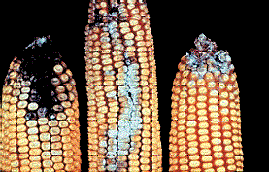
Figure
1. Corn earworm injuries followed by fungus
attack
|
|
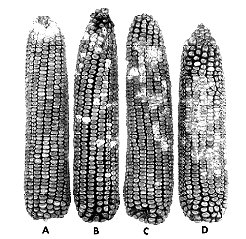
Figure
2. Fusarium
ear rot: (A) rot at tip of ear following damage by earworms of birds;
(B) Scattered rot, largely preceded by growth cracks; (C) extensive rot
following earworm injury; (D) severe rot after soaking by rain.
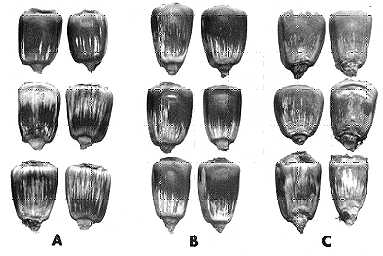
Figure
3. Corn
kernels with white streaks caused by infection with Fusarium Cephalosporium,
and Nigrospora. White streaking is a sure sign the kernels
are infected with fungi.
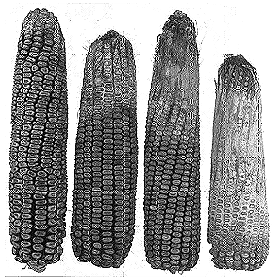
Figure
4. Giberella
ear rot, uniform rather than scattered infection ranging from a small
amount on the tip of the ear (left) to complete rotting (right).
|
Symptoms
1. Fusarium kernel or ear rot, caused by the fungi Fusarium
moniliforme and F. subglutinans (teleomorphs Gibberella
fujikuroi and G. subglutinans), is the most widespread disease
attacking corn ears in Illinois. The occurrence of these fungi increases
when harvest is delayed beyond physiological maturity. The first symptom
is a salmon pink-to-reddish brown discoloration of the caps of individual
kernels or groups of kernels scattered over the ear. Rot seldom involves
the whole ear. As the disease progresses, infected kernels become covered
with a powdery or cottony-pink mold growth composed of large numbers of
microscopic spores (Figure 2). Kernels infected late in the season develop
whitish streaks on the pericarp (Figure 3). The same fungi are commonly
found in stalks and seeds that appear normal.
Infection commonly follows some form of injury. Bird feeding encourages
infection at the tip of the ear. Kernels damaged by growth cracks, other
pericarp injuries, or the feeding of European corn borers or corn earworms
usually rot. Disease development and spread are favored by dry, warm weather.
2. Gibberella ear rot or red ear rot, caused by the fungus Gibberella
zeae (anamorph Fusarium graminearum, synonym F. roseum
f. sp. cerealis "Graminearum"), is common in Illinois
in some years. This fungus, however, is much more important as a major
cause of stalk rot. A reddish mold, usually starting at the tip of the
ear, is characteristic of Gibberella ear rot. All kernels become reddish
as the fungus colonizes the entire ear. The husks may adhere tightly to
the ear and a pinkish to reddish mold often grows between them (Figure
4). Superficial, speck-sized, bluish black perithecia occasionally develop
on the husks and ear shanks. The corn ears are generally susceptible only
when they are very young, and cool, wet weather within 3 weeks of silking
favors disease development. Ears infected early in the season may rot
completely, although complete rotting is rare in Illinois. Ears with loose,
open husks are often more susceptible than those with good husk coverage.
Sap beetles are capable of transmitting conidia and ascospores of the
fungus, both within and between corn ears, thus increasing the amount
of ear rot. Inbreds and hybrids differ in susceptibility.
Corn infected with Gibberella ear rot is particularly toxic to hogs,
dogs, and other animals with similar digestive systems, causing vomiting,
dizziness, loss of weight, or even death in severe cases. Hogs refuse
infected corn on the ear when 5 to 10 percent or less of the kernels are
rotted. When such corn is ground, hogs must eat it or starve. Infected
corn is also toxic to humans.
|
|
3. Nigrospora ear rot or cob rot is caused by the fungus Nigrospora
sphaerica, synonym N. oryzae, teleomorph Khuskia oryzae.
The disease is widely distributed, but its prevalence varies greatly from
year to year. Affected ears, which are not conspicuous until harvest,
are chaffy, weigh less than healthy ears, and have kernels which are loose
on the cob. Shanks, bases, and cobs of badly infected ears are often shredded,
particularly when the ears are picked mechanically or later when the ears
are shelled. In shelling, the cobs break into small pieces. Many diseased
ears are knocked to the ground by mechanical pickers. Infected ears show
large numbers of speck-sized, jet-black spore masses scattered in the
shredded pith of the cob and on the tip ends of the kernels (Figure 5D).
Affected kernels are slightly bleached, often with whitish streaks starting
at the tips and extending toward the crowns, and may show a gray mycelial
growth (Figure 6). Pound for pound, Nigrospora-rotted corn has almost
the same nutritive value as healthy corn. Infection usually starts at
the butt end of the ear although sometimes at the tip. Damage is most
severe when normal plant growth is arrested or plants are killed prematurely
by frost, drought, hail, stalk or root rots, leaf blights, insect damage,
root injury, or infertile soil.
4. Diplodia ear rot or dry rot, caused by the fungus Diplodia
maydis, synonym D. zeae, was formerly a serious ear rot in
Illinois, but is uncommon now. The same fungus is commonly associated
with stalk rot and may cause a seed rot-seedling blight. The husks of
ears which are infected early appear bleached or straw-colored, in contrast
to green healthy ears. Infections occurring within 2 weeks after silking
cause the entire ear to be gray-brown, shrunken, very lightweight, and
completely rotted (Figure 7). Lightweight ears stand upright, with the
inner husks stuck tightly together and to the ear by white mycelial growth.
Ears infected later in the season usually show no external evidence of
disease. When the husks are opened a white mold is seen growing between
the kernels. All or part of an ear may be rotted. In still later infections,
the white mold may or may not be visible between the rows of kernels.
Ears sometimes appear healthy until after shelling, when the brown germs
and dead kernels become evident. Infection usually begins either at the
base of the ear progressing toward the tip or at an exposed ear tip, but
can also advance from the stalk through the shank and into the ear.
Speck-sized, black fruiting bodies (pycnidia) of the Diplodia
fungus are often found scattered on the husks and sides of the kernels
(Figures 8 and 5B) as well as the floral bracts and cob tissues. The pycnidia
are filled with thousands of microscopic spores that may be carried considerable
distances by the wind to initiate new infections. Rotted ears have both
reduced nutritive value and reduced palatability to hogs. Dry weather
early in the season followed by abnormally wet weather just before and
after silking favors ear infection. Ears are most susceptible from silking
to about three weeks later. Hybrids with poor husk coverage or thin pericarps
are often very susceptible. Some isolates of Diplodia maydis may
induce vivipary (premature germination of kernels on the ear).
|
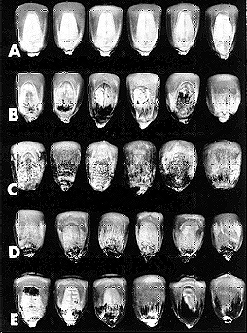
Figure
5.
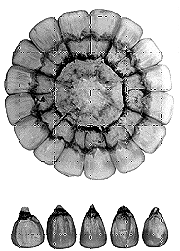
Figure
6. Nigrospora ear rot. Note black dots at ends of kernels and in cross
section of the ear. Whitish streaks on kernels are due to air channels
in the pericarp. Similar streaking occurs in kernels infected with Fusarium
moniliforme and Cephalosporium acremonium.
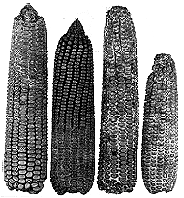
Figure
7. Diplodia ear rot. Lightweight mumified ear at right resulted from
an early infection. The other ears were infected later.

Figure
8.
|
|
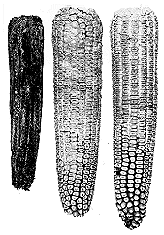
Figure 9.
Gray ear rot. Early infection (right) causes ears to be shriveled
and black; late infection (left) may resemble Diplodia ear rot.
Sclerotia, rather than pycnidia, are produced.
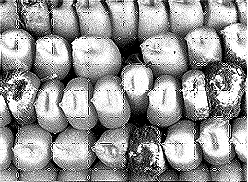
Figure 10.
Penicillium rot. Note the powdery mold growing on ans between the
kernels.
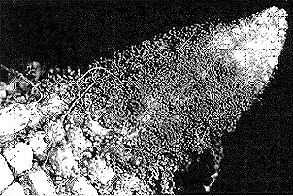
Figure
11. Aspergillus ear rot (Aspergillus
glaucus group)
(courtesy J. Tuite).
|
5. Gray ear rot, caused by the fungus Botryosphaeria zeae,
synonym Physalospora zeae, anamorph Macrophoma zeae, is
rare in Illinois and occurs only in restricted areas. Early infections
may produce symptoms similar to those of diplodia ear rot: (1) a grayish
white mold develops on and between the kernels, usually starting at the
base of the ear; (2) in early infections the husks are bleached and adhere
tightly to the ear; (3) the ears are lightweight, stand upright, and at
harvest are slate gray instead of grayish brown, as in Diplodia ear rot;
and (4) when the shank and butt are rotted, the ear breaks off. In later
stages, gray ear rot may be distinguished from Diplodia by the presence
of numerous, small, black specks (sclerotia) scattered throughout the
interior of the cob, on the husks, and under the seed oat of the kernels
(Figure 5C). Kernels may develop a uniform slate gray to black streaking.
The fungus growth on the surface of the ear and between the kernels is
also a darker gray than on Diplodia-rotted ears. Early infection usually
causes the ears to be shriveled, black, and mummified (Figure 9). Disease
development is favored by extended periods of warm-to-hot weather for
several weeks after silking.
6. Penicillium rot (Penicillium spp.) is found occasionally,
particularly on ears injured mechanically or by corn earworms and European
corn borers. The typical powdery, blue-green or green mold grows on and
between the kernels (Figure 10), which are frequently bleached and streaked.
Damage usually occurs at the tip of the ear, but may be found on other
parts. The same fungi cause seedling blight and "blue-eye" storage
rot of shelled corn with a high moisture content.
7. Aspergillus ear rot (Aspergillus spp.) is ordinarily
of little importance before harvest. However, Aspergillus infections often
follow drought stress and damage done by corn earworms and European corn
borers and other insects. The causal fungi bring about serious losses
in stored corn, on the ear or shelled. A tan, sooty-black, greenish, or
greenish yellow mold grows on and between the kernels (Figure 11). Damage
is most common at or near the tip of the ear. Silk infection is favored
by high day and night temperatures.
Certain Aspergillus fungi (A. flavus and A. parasiticus)
that cause ear and kernel rots also produce aflatoxins. Aflatoxins are
potent carcinogens that can cause serious feeding problems in a wide range
of animals. Fortunately, aflatoxins are rarely found in the field in Illinois
because temperatures at or near harvest rarely exceed 80 F (27 C), the
temperature at which these fungi begin to produce significant quantities
of aflatoxins. In Illinois, aflatoxins are usually the result of the activities
of A. flavus and A. parasiticus invading growth cracks and
injuries of shelled corn in storage. Corn planted and harvested late and
grown under nitrogen stress more commonly contain aflatoxins prior to
harvest than corn grown under good management practices and supplied with
adequate nitrogen.
|
|
8. Trichoderma ear rot (Trichoderma viride) is evident
as a green, fuzzy mold growing on and between the husks and kernels (Figure
12). Trichoderma is usually secondary to insect or mechanical damage
to the ear.
9. Cladosporium kernel or ear rot (Cladosporium herbarum,
synonym Hormodendrum cladosporioides) occasionally has been found
in Illinois, especially following an early frost. Symptoms include the
development of dark, greenish black, blotched or streaked kernels scattered
over the ear (Figure 5E). The black discoloration shows first near the
tips of the kernels and develops toward the crown in more or less irregular
streaks. The fungus may also invade crowns damaged by growth cracks. Further
rotting may occur during storage. When completely colonized, the ears
are dark and lightweight.
10. Black ear rot (Biplorais zeicola, synonym Helminthosporium
carbonum, Races 1 or 2; Bipolaris maydis, synonym Helminthosporium
maydis, Race T; and Exserohilum rostratum) synonym Helminthosporium
rostratum, is occasionally found, mostly on certain inbred lines.
The same fungi also cause stalk rots, leaf blights, and seedling blights.
Damaged ears have a black, "felty" or velvet-like mold growth
over and between the kernels (Figure 13). Such ears appear to have been
charred by fire.
|
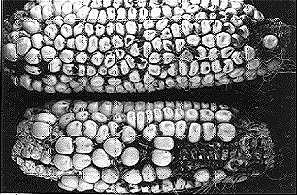
Figure
12. Trichoderma ear rot.

Figure
13. Clack ear rot. Corn
ears from an inbred
attacked by
Helminthosporium carbonum, Race 1.
|
|
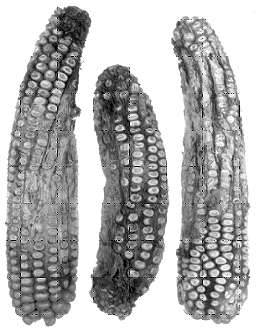
Figure 14. Rhizopus
ear rot.
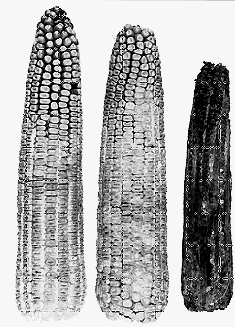
Figure
15. Physalospora ear rot.
|
11. Rhizopus ear rot (Rhizopus spp.) is characterized
by a coarse white mold over the ear in which numerous black sporangia
appear as black specks (Figure 14). Rhizopus rot is usually found
only on ears injured by insects or hail a few weeks after silking
during or following hot, very humid weather.
12. Physalospora ear rot (Botryosphaeria festucae,
synonym Physalosporza eicola, anamorph Diploda frumentii)
is rare in Illinois. The disease develops as a dark brown-to-black,
"felty" mold growth on all parts of the ear (Figure 15).
Mildly infected ears may have a few blackened kernels near the base
of the ear. Warm, humid weather favors infection.
13. Rhizoctonia ear rot (Rhizoctonia zeae), rare
in Illinois, is recognized in its early stages by a salmon-pink
mold growth on the ear. Infected ears later become dull gray. Numerous
white to salmon-colored sclerotia develop on the outer husks with
the sclerotia later turning dark brown to black. Warm-to-hot, very
humid weather is favorable for infection.
Back to Top |
|
The fungi that cause
ear and kernel rots of corn overseason in crop residues, in or on the soil surface,
or in stored grain. The fungi tend to increase in numbers if corn is grown in
the same field year after year. However, these fungi are so common and widespread
in the Corn Belt that crop rotation and a clean plowdown of crop residues would
make little difference in the total inoculum levels unless essentially all the
corn growers in a county followed those practices. The fungi, except Rhizoctonia
and Botryosphaeria festucae, produce large numbers of microscopic spores
that are disseminated by air currents, rain, birds, insects, mites, and humans.
The spores germinate at favorable temperatures in the presence of moisture. The
resulting hyphae penetrate the husks, kernels, cob, or shank. Several ear- and
kernel-rotting fungi also cause stalk rot, seed rot-seedling blight, and leaf
blight. |
- Grow resistant varieties. Inbred lines differ in their resistance
to the various ear- and kernel-rotting fungi and transmit their reaction
to their hybrid combinations. No inbred line or hybrid, however, is
completely resistant to all ear-rotting fungi. Corn breeders usually
discard the most susceptible inbreds and do not use them in hybrid
combinations. Hybrids with poor husk coverage or weak seed coats,
in which kernels tend to "pop" or "silk cut",
are often more susceptible to infection by certain ear- and kernel-rotting
fungi.
- Grow full-season, adapted hybrids that are resistant
to stalk rots and leaf blights.
- Practice balanced soil fertility, based on the results
of a soil test. Where possible, irrigate during extended droughts.
- Control corn earworms and European corn borers,
where practical, by timely applications of insecticides, as recommended
by University of Illinois Extension Entomologists.
- Harvest the corn as soon as moisture levels permit.
To avoid unnecessary injuries to the kernels, the combine should be
properly adjusted and run at the recommended speed.
- Store ear corn and shelled grain at the recommended
levels of moisture content: below 18% for ears and 13 to 15% for
shelled corn. Where possible, aerate the grain to maintain a uniform
temperature of 40 to 50 (4 to 10 C) throughout the bulk.
- Store only properly cleaned grain in a bin that has
first been thoroughly cleaned of debris. This practice will limit
the development of ear and kernel rot as well as storage rot fungi.
|
Thorough plowing-under of crop refuse and rotation with nonsusceptible crops
(such as soybeans, small grains, forage legumes, and grasses) are of doubtful
value in controlling ear and kernel rots in Illinois.
Back to Top
For further information concerning
diseases of crucifers and other vegetables, contact Mohammad Babadoost, Extension
Specialist in Fruit and Vegetable Diseases, Department of Crop Sciences, University
of Illinois at Urbana-Champaign. University
of Illinois Extension provides equal opportunities in programs and employment.
|



